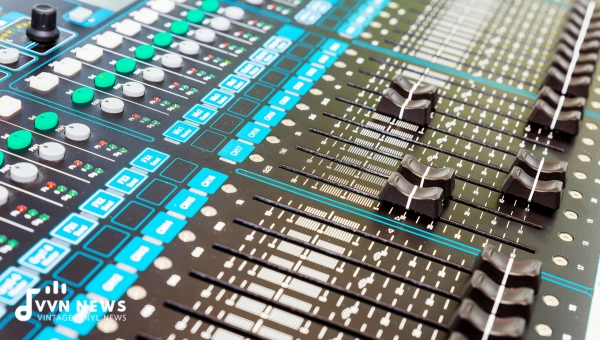As an audio enthusiast, I’ve always been captivated by the nuances of sound production. One pressing question that many ponder is, “How can we mix bass in stereo, especially when considering elements like the kick drum?” This isn’t as straightforward as it sounds.
The art of audio engineering is a mesmerizing blend of technical mastery and creative flair, bringing forth the best in music.
In this exploration, we’ll dive deep into stereo mixing, bass frequency overlaps, kick drums, and more. Is it truly optimal to mix bass in stereo with the kick drum? Join me on this sonic journey to find out.
Kick Drum and Bass in Music Production
Before delving into the depths of mixing, it’s crucial to comprehend the foundational elements that contribute to the overall sound.
What is a Kick Drum?
The kick drum, also known as the bass drum, is one of the central components in most music genres, specifically in electronic music, pop, and rock.
This drum provides the low-frequency ‘punch’, often syncopated with the song’s tempo, generating a groove or rhythm that drives a song forward.
The kick drum’s unique sound comes from its pitch range – generally occupying the low frequencies between about 50hz to 100hz.
The Role of Bass in Music
The bass plays an equally important part. It not only imparts depth to your music but also adds an essential layer of harmony by providing tonality (defining whether your song is major or minor) and rhythm.
In terms of frequency response, bass typically occupies frequencies around 20Hz-200Hz.
To create a well-balanced mix, it’s essential to understand how these elements function individually and how they can harmonize together without overpowering one another.
An understanding of how to manage this potential for a clash between kick drum and bass can make or break your mix, leading us back to our original query: Can we mix kick drum & bass in stereo? To unravel this question further – let’s delve right into it!
Can We mix bass in stereo?

In truth, there’s no definitive “yes” or “no” to this question. The decision to mix the kick drum and bass in stereo depends on multiple factors including musical genre, the specific tonal qualities of the individual elements, and most importantly, your creative objectives for the mix.
When done cautiously and tastefully, blending these elements in stereo can potentially add depth and fullness to your tunes.
Bass frequencies are omnidirectional, meaning they aren’t easily pinpointed as coming from a left or right direction – thus practically mono.
If the kick and bass sounds are panned too wide apart, it may lead to an unbalanced or less powerful mix, particularly on large sound systems used in clubs or live venues.
Stereo vs. Mono for Mixing Bass & Kick Drum
Before delving into the specific scenarios of mono and stereo mixing for kick drum and bass, let’s first clarify what mono and stereo sound are.
Defining Stereo and Mono Sound
Mono sound, short for monophonic sound reproduction, is single-channel audio. In simpler terms, it’s the same audio information coming out of both speakers or headphones.
It may not have width or depth, but it’s powerful due to its centralized focal energy. It punches you.
On the other hand, stereo sound refers to stereophonic sound reproduction using two or more independent audio channels.
This creates an illusion of multi-directional audible perspective granting your audio production more depth and breadth.
Mixing in Stereo: The Pros and Cons
One vital point for consideration in this debate is how the low frequencies (which include kick drum and bass) behave in stereo mixing.
Pros:
- Depth & Dimension: With stereo mixing, you’re no longer constrained by a singular placement of sounds as with mono mixing. You can create a more immersive experience with depth and dimension as if you’re filling a three-dimensional space with sound.
- Creative Opportunities: There’s certainly more room for creative choices when it comes to the spatial placement of instrument tracks within the stereo field.
Cons:
- Phase Cancellation Issues: The way low frequencies interact can create phase cancellation issues when mixed in stereo. When two signal phases cancel each other out, they are ‘fighting’ each other and can cause your mix to lose punch or disappear altogether when summed to mono.
- Mono Compatibility: Many clubs still play music in mono. That means beautiful effects hidden in your mix’s width could be lost if the mix was done purely in stereo.
We must understand these nuances before diving into mixing tasks. Done correctly it can elevate the sonic experience; done poorly it could just end up muddying the waters.
Also Read: 27 Best Bass Songs [Experience The Deepest Grooves Of Music]
Panning Bass & Kick in the Stereo Field

So what do we mean by ‘panning’? In music production, panning refers to the distribution of a sound signal (either mono or stereo) into a new stereo or multi-channel sound field.
Essentially, it’s about deciding where on the left-right spectrum you want particular elements of your track to sit in.
What is Panning?
Panning can be explained as stereophonic sound reproduction in which sounds are ‘moved’ or spread out through two or more speakers.
By adjusting the pan control on your music software, you can direct a particular part of your mix to the left speaker, right speaker, or anywhere in between.
The Impact of Panning on Bass and Kick
When it comes to planning your kick drum and bass, caution is needed.
Due to the low-frequency nature of these elements, wide stereo panning can lead to numerous issues such as frequency cancellation or muddiness in your mix particularly when played on large club-style systems.
Bass frequencies are generally omnidirectional meaning they are less discernible in terms of directionality than higher frequency elements (imagine trying to figure out where a subwoofer is located just by listening).
If you excessively pan bass frequencies left or right, you may end up with an unbalanced mix that lacks power and cohesion.
The kick drum also operates within a low-frequency range but requires greater care due to its percussive nature and function as a key rhythmic element.
Wide panning might create inconsistencies in the sonic image listeners perceive from different listening environments.
In essence, while there’s no absolute prohibition against mixing kick drum & bass in stereo via panning techniques, it should be done with consideration for the potential pitfalls and impacts on your overall mix quality.
Reverb on Bass and Kick
Reverberation, or reverb for short, is an incredible tool in our arsenal for sound mixing. At its core, it gives sounds a sense of space and depth.
Utilizing reverb on bass frequencies such as the kick drum and bass line often requires careful consideration. Let’s explore why.
Importance of Reverb in Sound Mixing
As audio engineers and music producers, we adore reverb for its ability to add dimension to our mixes.
It can make tracks seem larger than life, creating a space where instruments seem to resonate from all directions.
Reverb is not just about creating ambiance or a sense of space it can also help distinguish different elements in your mix, giving each instrument or voice its distinct ‘location’ in the sonic landscape.
This helps prevent clashing and overcrowding of frequencies, especially when dealing with complex arrangements.
In terms of low-end frequencies such as those produced by the kick drum and bass line delayed sounds can muddle your mix more than enhance it.
How to Use Reverb Effect on Bass & Kick
When it comes to applying reverb on low-frequency elements like bass or the kick drum:
- Less is more: Try to use as little reverb as possible for these elements; too much can quickly muddy your mix.
- Experiment with high-pass filtering: Cutting low frequencies from your delayed sound might help preserve clarity.
- Be aware of potential clashes: If you add reverb make sure it’s not causing any phase issues with other frequency bands.
- Short decay times: Longer reverbs create more chance for frequency overlap which could clutter up the lower end.
Yes, you can certainly apply some stereo treatments like panning or adding some well-thought-out reverb to create depth and nuances without wreaking havoc on your mix’s clarity and power with consideration for both technical implications along creative desires driving your unique sound.
Also Read: 15 Bass Programming Tips For MIDI & Synths [Step Up Your Beat]
Gain Stereo Width on Your Bass Using the Chorus Effect

Adding width to your bass can be a game-changer for your mix, and one technique that can be incredibly effective is the use of the chorus effect.
What’s the Chorus Effect?
The chorus effect, typically found in audio software and hardware alike, works by duplicating the signal of your audio track and slightly detuning or delaying the copies. This process creates a thicker, richer sound—almost like multiple instruments or voices are playing in unison.
The result can be described as similar to a choir (hence the name ‘chorus’), where each voice has minor variations in timing and pitch, which combine to create a fuller, more expansive sound. This effect is highly versatile and is used across many genres to add depth and width to recordings.
Using Chorus to Enhance Your Mix
To gain stereo width on your bass with a chorus effect, follow these basic steps:
- Apply a mono-chorus plug-in on your bass track: Initially applying this in mono allows you better control over how much of the chorus effect is added into the mix.
- Slowly adjust the ‘Wet/Dry’ knob: This determines how much of the effect is blended with your original sound.
- Listen closely as you tweak settings: The key parameters to experiment with are ‘Rate’ (the speed of modulation cycles) and ‘Depth’ (how far those modulations stretch from their starting point).
Subtlety is key when using choruses; too much could make your sound messy while too little might not show any noticeable difference at all.
Using chorus effects judiciously can give an exciting stereo width to bass sounds, making them prominently present in stereo playback devices.
Benefits of Stereo Mixing for Kick Drum and Bass
Stereo mixing can indeed bring depth, breadth, and richness to your sound. Here are some specific advantages when it comes to kick drum and bass:
- Dimension and Depth: Stereophonic audio provides a three-dimensional soundscape, enhancing listener immersion. When used correctly with low frequencies such as bass and kicks, this depth can add substantial quality to your mix.
- Broadened Soundscape: With good stereo mixing, your basslines or kick drums can span across the aural landscape rather than being confined to one point in the space.
- Balanced Harmonics: Kick drums and basslines often have upper harmonics straying into mid-frequency territory. Stereo mixing allows these harmonic elements to be manipulated separately from the fundamental frequencies, lending more balance and texture to your track.
- Clarity in Mixes: Using stereo techniques wisely can lead to less competition between your sounds. This might mean greater clarity in your mixes when multiple elements operate within the same frequency spectrum.
- Creative Flexibility: Panning isn’t the only tool that can create stereo movement. Reverb sends, delay throws, or tools like chorus/flanger/phaser on the harmonic content of these elements allow for a wider stereo landscape while maintaining mono compatibility.
While there are clear benefits of using stereo for your low-end frequencies, careful handling is still necessary lest you end up with phasing issues or a lopsided mix.
Also Read: Transpose Bass Clef To Treble Clef [How To Guide & Tips]
The Challenges of Stereo Mixing for Kick Drum and Bass

Stereo mixing for kick drum and bass might seem like an engaging idea at first, but it’s not without its challenges. Here are some prominent obstacles that you might come across:
- Phase issues: Phase issues can occur when two signals of the same frequency get out of sync, resulting in diminished volume or outright cancellation. Particularly in a stereo mix, these phase cancellations can result in uneven frequency response or a ‘hollow’ sounding mix.
- Alignment problems: Aligning the kick drum and Bass becomes trickier when mixed in stereo. These backbone elements of a song’s rhythmic structure must remain tightly aligned at all times.
- Inconsistency across various listening environments: Different speakers, headphones, and sound systems reproduce stereo fields differently. A track may sound good on your studio monitors but may lose low-end definition or power on smaller bookshelf speakers or earbuds if the bass frequencies are panned too wide.
- Impact on mono compatibility: Not all playback systems are capable of reproducing stereo sound. Radio broadcasts, club PAs, and portable speakers often output mono sound; therefore, you could potentially reduce your mix’s compatibility with such systems if kick drum and bass are mixed extensively in stereo.
Indeed there are many things to consider here the skill lies in knowing how to navigate these potential challenges successfully for optimal results.
Different Approaches to Stereophonic Kick Drum and Bass
Before we dive into specifics, it’s important to underscore the fact that mixing is an art form.
While there are best practices, rules are occasionally made to be broken or at least bent in the service of a creative vision.
Let’s explore some different approaches to handling kick drum and bass in a stereophonic context.
Get Creative with Panning Options
- Subtle Shifts: Rather than wide panning, subtle shifts can add space to your mix without causing imbalance or other technical issues. For instance, positioning the bass just slightly off-center while keeping your kick drum in mono can provide a pleasing sonic distribution.
- Frequency-based Panning: This involves splitting the frequency spectrum of your bass into different bands and panning them separately, leading to a fuller sound while avoiding heavy low-end buildup on either side of the mix.
Exploring Stereo Effects Processing Techniques
- Chorus Effects on Bass: The chorus effect can give the illusion of widening the stereo field by duplicating and detuning the original signal slightly. Applying this trick to high-frequency content within your bass can add depth and character.
- Reverb on Kick: Applied carefully, reverb can make your kick drum feel bigger and more impactful without causing muddiness or interfering with rhythms.
- Dynamics Processing: Compression or other dynamics processing tools applied judiciously can help keep both your kick and bass elements punchy while fitting them nicely into a stereo mix.
Successful mixing is about balance, perspective, and nuance. While it’s essential to comprehend audio theory and conventions, do not let these limit your creative endeavors.
Still, always listen attentively to how each adjustment affects the overall sound and feel of your mix before making final decisions.
Also Read: How To Transpose Treble To Bass Clef [Music Guide]
FAQs About Mixing In stereo
How do you mix bass and drums together?
Mixing bass and drums together involves achieving a balance where neither overpowers the other. This can be done by equalizing both input signals such that no major frequency conflicts occur. Panning may also be used if both signals are in stereo.
Should kick and bass be at the same volume?
The volume of kick and bass should not necessarily be the same. It’s more about achieving a balance where one doesn’t overpower the other. Adjusting volumes should be made based on the desired feel and genre of the music.
Do you mix drums in mono or stereo?
Drums can be mixed in either mono or stereo depending on the desired sound. Mono can potentially offer a punchier sound, while stereo can give a wider, more immersive experience.
How do I make my bass more stereo?
To make your bass more stereo, you can use plugins designed for stereo widening or use the ‘duplicate and pan’ method where you create two copies of the bass track, pan one left and the other right, then slightly delay one of them.
What is the best frequency for a kick drum?
The best frequency for a kick drum usually lies within the 50 to 100Hz range, as it provides the necessary ‘punch’ or ‘thump’. However, for a fine-tuned kick, frequencies up to 2.5 kHz may also be enhanced.
Conclusion
Mixing the kick drum and bass in stereo is a technical decision that requires an understanding of fundamental audio principles.
The appropriate implementation depends on context, desired sound, and medium of playback.
It’s all about balance too much stereo can conflict with mono compatibility, and too little might cause your mix to lack depth.
Proceed with caution and always be prepared to experiment. After all, standing out in this sound-filled world often means breaking conventions and exploring uncharted sonic terrains. Happy mixing!








